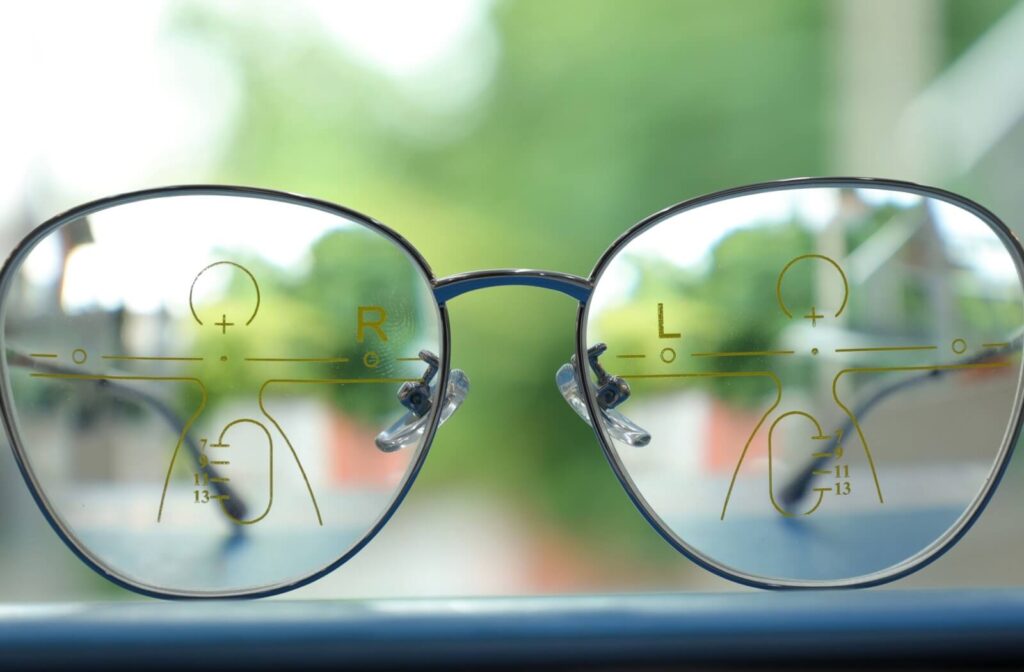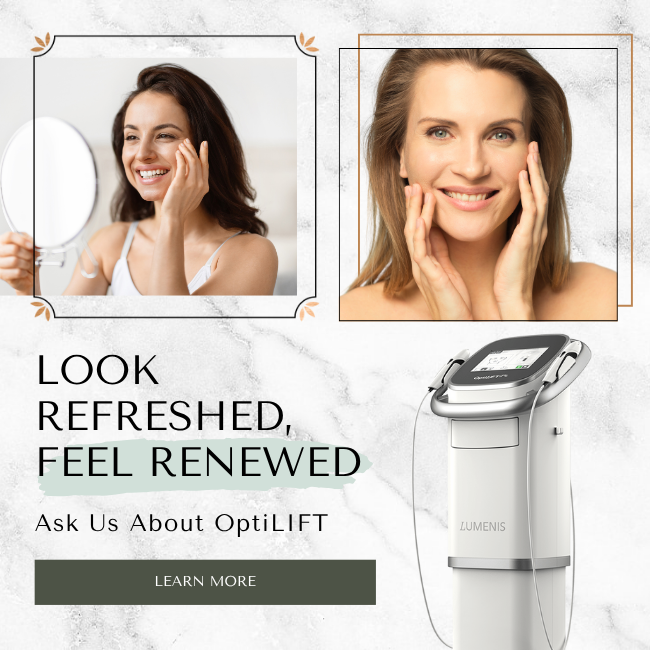Although the fun in picking out new eyeglasses lies in frame selection, the lens holds a functional purpose. No pair of eyeglasses is exactly the same. People gravitate towards certain lens types and coatings, like single-vision glasses with a blue-light filter.
As your vision changes, you may gravitate towards other lens options, like bifocal or progressive lenses. They correct vision across multiple distances but differ in design, purpose, and price.
Bifocal lenses have a visible line across the lens, separating near and far vision correction.
Progressive lenses offer a wider range of correction, addressing near, intermediate, and far distances in one continuous lens. With multiple zones of focus, progressive lenses are more costly.
No one lens option is necessarily “better”. Choosing between the two will depend on your visual needs, lifestyle, and preferences. You can always ask your optometrist for a lens recommendation!
Are Bifocal & Progressive Lenses the Same?
Bifocal lenses are a classic staple. They have a distinct line (visible to the wearer and others) across the lens, sectioning for near and distance vision correction. The bottom section of the lens supports up-close tasks like reading or knitting, while the top supports clear distance vision, such as driving.
Progressive lenses take a modern, more seamless approach. The lens transitions gradually between near, intermediate, and distance vision without visible lines. This “no-line” solution provides a smoother experience for tasks like looking at a computer screen or focusing on distant objects.
Although the difference is minute, it affects how easily and naturally your vision aligns with your daily tasks.
For example, if you frequently switch between reading (up close) and computer work (intermediate), progressive lenses seamlessly correct a broader range. The noticeable line marking bifocal lenses and no intermediate distance will make computer work more challenging.
Why Use Bifocals or Progressives?
Both types of lenses help address several vision concerns, most notably presbyopia.
Presbyopia is a common age-related refractive error that develops in people around their mid-40s. It occurs when the eye’s natural lens gradually loses flexibility, making it harder to focus on nearby objects. It’s a natural part of the aging process, affecting nearly everyone to some extent.
As our bodies grow older, we become more likely to develop age-related vision changes, like presbyopia, further emphasizing the importance of routine eye exams. The sooner we detect any changes or concerns, the easier they become to manage.
Though older adults wear these lenses more commonly, the unique design of these lenses also helps support children’s developing eyes, as an effective option for myopia management.

Adjusting to Your New Lenses
Although bifocal or progressive lenses save you from switching between multiple glasses, they require an adjustment period, especially for first-time wearers.
It’s relatively common, because your eyes and brain may need a little time to adapt to how the lenses refract incoming light. These lenses alter how you perceive depth and transition focus, which can feel slightly disorienting, particularly with progressives that have multiple zones.
If your new lenses feel slightly off at first, don’t give up on them right away! As your eyes and brain adjust, your vision will feel clearer and more comfortable..
With the right approach, you can enjoy a smoother adjustment period:
- Wear them consistently: Regularly wearing your new bifocals or progressives helps your brain adapt faster. Take breaks if you have to, but avoid switching back to your old lenses.
- Move your head, not just your eyes: To help with the change in depth perception, try moving your head instead of just your eyes when looking at objects at different distances.
- Focus on the right lens portion: Keep your reading material approximately 16 inches from your face and make sure you’re using the lower (reading) portion of your glasses. As you read, move the reading material up and down instead of your head.
- Practice makes perfect: Reading or working on a computer may feel challenging at first, but with practice, you will train your eyes and brain to find the right focus quickly.
- Be patient: Adjusting to new lenses can take a few days to a couple of weeks. Don’t get discouraged if it’s taking longer than expected, everyone adapts at their own pace.
- Schedule a check-in: Work with your optical team to confirm your glasses fit correctly on your face. Some minor frame adjustments can significantly improve comfort.
If your eyeglasses still feel slightly off even after practicing these tips, don’t hesitate to visit your optometrist. Together, we can make any necessary adjustments so you can enjoy clear, comfortable vision!
Bifocals vs Progressives: Which is Better?
Truthfully, there’s no universal “better” lens option because everyone’s vision needs, lifestyle, and comfort preferences are different.
However, if you’re on the fence with either option, here are a few factors to consider:
- Daily activities: If you’re constantly moving between tasks (reading, computer work, driving), progressives may be more convenient. Bifocals are a great option for near-and-far tasks like driving and reading.
- Aesthetics: Bifocal lenses have a noticeable line across them (which some wearers prefer). However, for a seamless option with no visible line (and greater visual range), progressives are the way to go.
- Adaptation period: Progressives generally require more time to adjust than bifocals, so keep this in mind, especially if you’re on a tight schedule.
- Overall cost: The overall cost of your lenses will depend on factors such as the strength of your prescription and any additional lens coatings. However, because progressive lenses offer one continuous lens with multiple zones of focus, they cost more than bifocal lenses.
Helping You See Clearly & Comfortably
Though bifocal and progressive lenses are distinct in design, purpose, and price, they offer a comfortable approach to vision correction. No option is necessarily better than the other. Rather, the key is choosing the lenses that fit seamlessly into your lifestyle to support your daily endeavors.
If you’re still unsure which option is right for you, connect with our Windsor Eye Care team to schedule an appointment. Together, we can try on frames and discuss lens options for your vision concerns!





